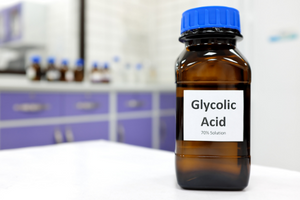Glycolic acid is one of the simplest organic compounds, used on a broad scale in contemporary cosmetology and in the chemical industry. This is because that hydracid has many valuable properties. What is glycolic acid? Below we present its short characteristics.

What is glycolic acid?
AHA acids (alpha hydroxyacids) cover various types of popular acids that we use on a daily basis. Examples include citric, lactic or malic acid. The AHAs also cover glycolic acid. What is it? This hydroxyacid is a solid that excellently absorbs water molecules from the environment.
There are several names denoting glycolic acid: its chemical name is 2-Hydroxyethanoic acid. That name was introduced by the International Union of Pure and Applied Chemistry (IUPAC) to facilitate the identification of that substance on a global market. This chemical compound can also be found under the following names:
- hydroxyacetic acid,
- alpha-hydroxyacetic acid,
- hydroxyethanoic acid.
Glycolic acid: chemical and structural formulas
How to define glycolic acid? Its structural formula is the following: HOCH2COOH. The molecular formula of this acid is: C2H4O3. Both formulas indicate that the substance contains both carboxyl and the hydroxyl groups, which are typical of alpha-hydroxyacids. And how can we obtain that acid in industrial conditions? Let’s check!
Hydroxyacetic acid: production
The contemporary cosmetic and chemical markets would be hard to imagine without substances such as AHAs, including glycolic acid. What is this semi-finished product made of? For decades, various methods of producing C2H4O3 were developed. It can be obtained, for example, by:
- A reaction of acetic (chloroacetic) acid derivative with sodium hydroxide (NaOH), which is a strong base. Obviously, glycolic acid will not be produced immediately. The production of that substance is only possible if the environment of both reacting ingredients is acidified.
- A reaction of formaldehyde with water gas (it is one of the most popular methods of the mass production of glycolic acid; however, the acquisition of the semi-finished product with this method generates a lot of waste).
Currently there is intensive work carried out on safe and ecological methods of producing hydroxyacetic acids. Chemists have already developed several new patents, which made it possible to isolate this precious compound from arable crops such as grapevine or sugar cane. These are highly promising technologies which reduce the consumption and emission of harmful compounds derived from manufacturing processes.
Glycolic acid: chemical and physical properties
How to recognise glycolic acid? The characteristics of that substance are as follows: it is a solid having the form of a white or transparent, crystalline, odourless powder. It decomposes at 100°C and melts at 80°C. It is assumed that glycolic acid has a density of 1.49 g/cm³ at around 25°C. It is a substance which should be used with particular caution, as it irritates skin, the eye mucosa and respiratory system organs.
What else distinguishes glycolic acid? The water solubility of that powder is very good and largely depends on the temperature of t5he liquid: the higher it is, the better the powder will dissolve to form a solution. Glycolic acid can also be dissolved in alcohols: ethanol, methanol or acetone. The substance reacts with aluminium and oxidants, which may even cause ignition.
Applications of glycolic acid
Today’s drug or household chemical stores offer various types of agents and formulations containing glycolic acid. Their application is very wide. Hydroxyacetic acid is a component of:
- concentrates designed for the cleaning of Gres tiles, joints and porous surfaces,
- specialised preparations for washing and sterilizing tanks, cisterns, production lines or equipment having contact with food,
- liquids used for cleaning public sanitary facilities.
Cleaning and washing concentrates with glycolic acid quickly remove dirt and microbes from different surfaces. This is why they are widely used in private homes, industrial plants and public facilities. This raw material is also desired by entities from the food, logistic and catering industries. It can also be found at schools and kindergartens.

Glycolic acid in cosmetics: a regenerating glycol for the face and body
Industrialists and pharmacists discovered long ago that glycolic acids are worth using on the face and skin. They are ingredients of creams, conditioners, shampoos, ointments and tonics as well as additives in washing gels, exfoliation products, etc. Formulations based on that acid are also used in beauty salons as part of rejuvenating treatments.
Why is glycolic acid increasingly popular? Its effects can be noticed within a few days. With that substance, the epidermis regenerates faster and recovers its natural colour and flexibility. Glycolic acid can also be used against discolouration, inflammatory conditions and scars. Amongst cosmetic ingredients, we can find it under the INCI name Glycolic Acid.
Glycolic acids: opinions
Contemporary consumers search for proven, high-quality chemicals that bring rapid effects and do not cause allergies. People are increasingly eager to choose natural glycolic acid and use cosmetics and chemicals which contain that ingredient. Hydroxyacetic acid, designed for professional use, is globally recognised as a substitute of many other acids produced artificially. Industrial plants use C2H4O3, for example, instead of hydrochloric acid which, once used, turns into highly poisonous and hazardous waste.
Biodegradable glycolic acids: opinions and benefits
Many manufacturers believe that powdered glycolic acid, derived from natural sources, is an excellent alternative to aggressive chemicals. The substance has a very broad range of application; when used in appropriate proportions and conditions, it is not harmful to humans or the environment.
In addition, biodegradable glycolic acid for the face, or a cleaning fluid containing that ingredient, do not increase the amount of toxic waste. They are only made of raw materials of natural origin, which quickly decompose under the influence of micro-organisms. Vegetable waste remaining after production can be converted, for example, into compost without occupying any additional space for landfills.
